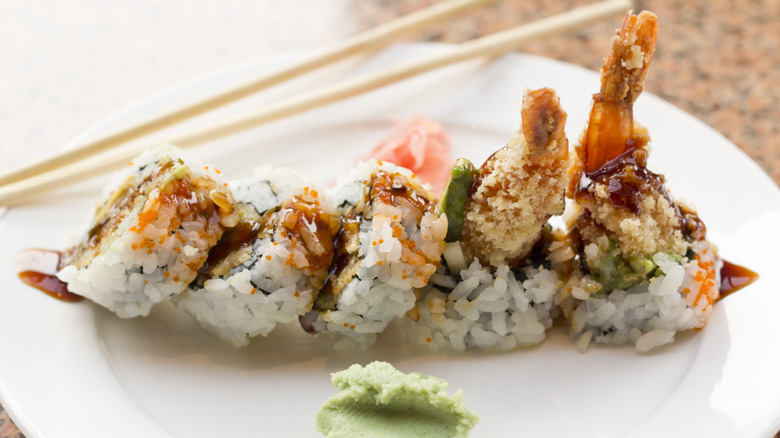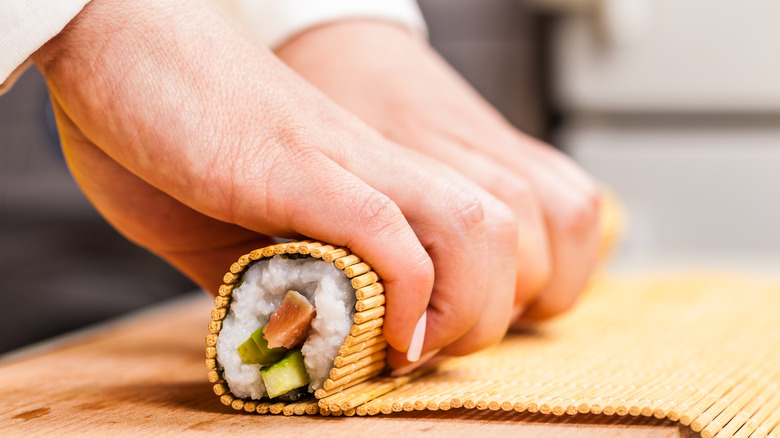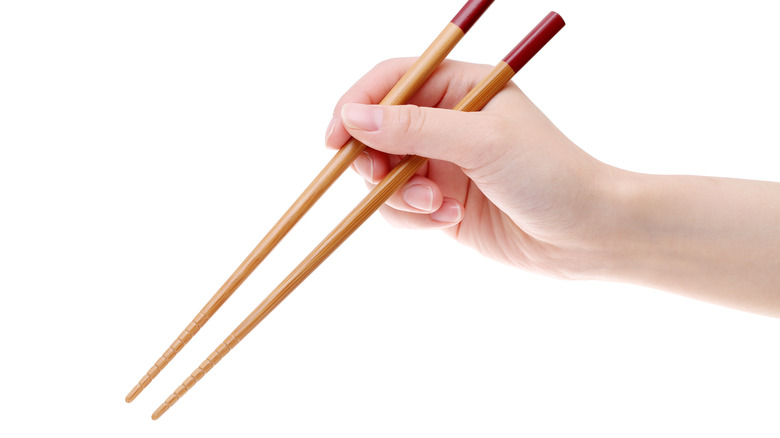Tiger Roll: What You Should Know Before Ordering
To the uninitiated, ordering sushi can present a monumental task. The presentation is gorgeous; a kaleidoscopic array of fresh seafood displayed like a work of art. But what's really lurking inside those fancy rolls? And what about the squeamish among us? You know who you are. You want to partake, but raw fish? Relax. According to SushiFAQ.com, not all sushi contains raw seafood, and if you're looking for a place to start, a tiger roll may be the perfect introduction.
Also known as shrimp tempura rolls, tiger rolls are named for their main ingredient, tiger shrimp (via MonkeySee). Individual preparations may vary, but a typical tiger roll will contain tempura shrimp, sushi rice, a sheet of seaweed, cucumber, and avocado. No raw fish here, folks — just fried shrimp, rice, and fresh vegetables.
One word of advice: If you're adamant about avoiding certain ingredients, be sure to ask your server to confirm what's inside before ordering. MonkeySee's recipe contains masago (which are fish eggs), while a tiger roll purchased from Eat Club would come with imitation crab. It's not uncommon for sushi chefs put their own spin on classics.
You can make a tiger roll at home
Sushi has a reputation for being difficult to prepare. As Business Insider reports, that's true when it comes to the art of making sushi. In Japan, sushi chefs may train for years before they're considered pros, learning precisely how to cut and prepare fish. If you're willing to settle for a not-so-perfectly formed roll, however, you could try your hand at a shrimp tempura roll recipe, like this simple one from Dinner at the Zoo. Their short-cut preparation relies on frozen shrimp tempura, which is available in many supermarkets. Other ingredients include avocado, cucumber, nori (aka seaweed sheets), and sushi rice. Of all the ingredients in a tiger roll, sushi rice can be the most challenging to find depending on your location. In a pinch, What is the Best Rice Cooker suggests substituting Arborio rice.
As you dig in, keep in mind that tiger rolls are higher in fat and calories than other many other popular rolls. SushiFAQ.com pegs one roll (not piece) at 508 calories and 21 grams of fat. Lighter raw fish-free options include California Rolls, which have 255 calories and 7 grams of fat per roll, and vegetarian-friendly Avocado Rolls, which have 140 calories and 5.7 grams of fat per roll.
How to eat a tiger roll
You've made a sushi date. You've perused the menu online. You know your order by heart. Your food arrives ... now what? Experimenting with new cuisines can bring unexpected challenges. What's the proper way to eat your tiger roll? Do you bite off the shrimp tail? Hold it like a handle? What if you've never used chopsticks?
Los Angeles Magazine created a comprehensive list of dos and don'ts for navigating a sushi bar, but here are the big takeaways: Never point with your chopsticks. Feel free to ask questions within reason (most sushi chefs enjoy sharing their insight, but remember they are working and might be a little busy). Each piece should be eaten in one bite. It's okay to eat with your hands (sushi was originally a finger food). And do not, under any circumstances, unroll your sushi. Doing so would be the ultimate act of disrespect to the chef's art.
The Muse explains the basics when it comes to accompaniments, so you'll know what you're looking at when the plates hit your table. The brown liquid is soy sauce. The green paste is fiery wasabi. Those delicate pink slices? Shaved pickled ginger. — save those to cleanse your palate between bites.
Now that you know the ins and outs of the tiger roll, you're all set to saddle up to the sushi bar.


